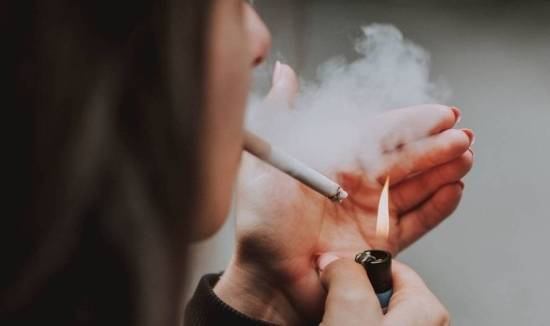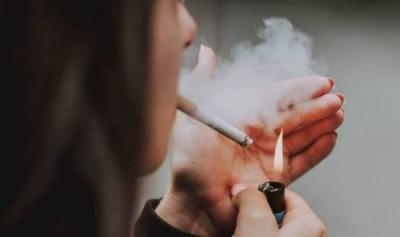Jordan has reached a critical stage where smoking has become a part of the behaviors of school students who purchase it "by the piece" from places just meters away from their schools, without realizing the significant risks it poses to their young bodies, potentially leading to serious health conditions. "It is no longer acceptable," as emphasized by King Abdullah II during a meeting held at the Husseiniya Palace last Monday, stating that "tackling the danger of smoking is a priority" and that "the health of our children should come above all else," urging the enforcement of public health law to combat smoking, especially among youth.
The Jordan News Agency (Petra) has explored the reasons behind the alarming levels of smoking prevalence among school and university students in Jordan. Social specialists, officials, and doctors confirmed that the root of this issue lies in the family's role in protection and oversight, the inadequate enforcement of laws against violators, and the general acceptance of smoking as a normal practice at home, in the street, and in public places, even in sight of children.
Several questions arise when discussing this phenomenon, including who is responsible for leading school and university students to tobacco and its derivatives, and why parents smoke cigarettes or narghile in front of their children as if the tobacco smoke surrounding them poses no health risks, including the risk of lung cancer.
**Health and Livelihood**
Public sector employee Ruba Al-Madihah stated that she had to choose between her health and her livelihood after repeatedly contacting her management to stop smoking without success. Thus, she opted to leave her job because health comes first, as she explained, namely "the varying forms of smoking from electronic cigarettes, electronic narghile, and regular cigarettes everywhere in her workplace."
Ruba noted to Petra that what has led Jordan to this situation, necessitating the King's personal intervention, is the weak enforcement of laws on violators, and the manner in which tobacco products are sold to those under the age of eighteen. There is also a lack of inspection raids at school entrances and premises, and a failure to apply penalties in reality to achieve both general and specific deterrence. Having been on unpaid leave for 1,400 days to protect her health from the dangers of smoking, Ruba indicated that Jordan is not the only country facing rising smoking rates to dangerous levels. However, what is alarming is that smoking has become easily accessible to school and university students without any real oversight, leading to significant health and financial losses for Jordan and leaving children to face a terrifying fate, which means the future of society will not be bright.
**No to Smoking**
Dr. Larisa Al-War, a founding member of the "No to Smoking" association, highlighted a survey conducted by the association in collaboration with the cancer control office this year titled "Protecting School Children from Tobacco Product Promotion Tactics." The survey revealed the extent of sales points within 150 meters of schools in two areas in the capital, Amman. According to the study, 70 percent of shops around 94 schools sell tobacco products, with 20 percent observed selling tobacco in "bulk," while around 80 percent of these shops did not post signs prohibiting the sale of tobacco products to minors.
Dr. Al-War stated that a study conducted in 2013 concerning smoking rates among school students showed that about 25 percent of students aged 13 to 15 were smokers, and more than 50 percent of them were able to easily purchase tobacco from stores. In a survey (STEPS) conducted in 2019 among adults, it was found that the rate of smoking traditional cigarettes reached 66 percent, while electronic cigarettes accounted for 15 percent. The age group between 18-44 years is the most consuming of tobacco compared to the 45-69 age group. There has been an increase in smoking, coinciding with the allowance of electronic cigarettes and heated tobacco, which are appealing to young users due to the various flavors, including banana, cherry, strawberry, and apple—all popular among children.
It is suggested that forced exposure to smoking is the primary motivation for adolescents to start smoking, with those subjected to secondhand smoke potentially suffering more due to smoking's impact on the frontal area of the brain and lung development.
**Media and Awareness**
Dr. Ghith Oweis, the Director of the Health Awareness and Media Department at the Ministry of Health, clarified that students aged 12-16 are increasingly eager to explore new things, including smoking, warning about its negative influences on academic performance and their growth. He affirmed that one study confirmed the prevalence of smoking among school students, noting that the promotion of tobacco in various shapes, designs, and flavors attracts students in the absence of an awareness of the risks involved.
Dr. Oweis added that the Ministry of Health is working on establishing legislation and drafting several laws, including a public health law that prohibits smoking in all forms in public places where children may be exposed to secondhand smoke, along with stiffening penalties against smokers in schools and kindergartens. This year, more than 400 enforcement officers have been appointed, compared to about 300 last year, who are tasked with penalizing and closing establishments that violate the law.
He reported that enforcement officers have conducted approximately 4,500 visits this year, resulting in about 740 warnings issued to violating establishments. In contrast, enforcement officers performed around 8,000 visits last year, leading to nearly 870 violations.
The number of smoking cessation clinics will increase this year to 29, starting from only five doctors initially, with the number of trained doctors for this purpose reaching 68 this year. The percentage of individuals quitting smoking among those who visit these clinics ranges between 6 and 9 percent.
**Health Impact**
Dr. Muntaha Al-Eidi, a specialist in lung and sleep disorders in children, has pointed to the difficulty of convincing teenagers accustomed to smoking to quit, particularly if the child is surrounded by smokers. This behavior correlates to an increased likelihood of hospital admissions due to repeated relapses caused by the inability to stop smoking.
Dr. Al-Eidi stated that the most common issues faced by smoking children include middle ear infections and early-stage asthma, as smoking weakens lung function. She affirmed that early-age smoking and prolonged smoking years increase the likelihood of cancer and cardiovascular diseases. Smoking is the primary irritant for the airways and diminishes the ability to control symptoms, regardless of the prescribed medication, unless exposure to smoking is curtailed. She explained that weakened respiratory function from smoking leads to compromised lung function and frequent relapses.
**Educational Aspect**
Educational counselor Dr. Baha' Al-Shawqifah mentioned that the penalty for smoking students in school starts with a warning and can escalate to expulsion. He confirmed that the first reason a student becomes a smoker is mimicking their surroundings.
Psychologist and educator Haneen Al-Batoush noted that smoking has become a prevalent phenomenon in schools, with high rates due to adolescents’ curiosity to experiment and their mistaken belief that smoking is a sign of maturity. She emphasized the importance of correcting adolescents’ misconceptions about smoking reducing stress and anxiety while expressing regret over the decline in parental oversight and the ease of obtaining smoking products amid ineffective law enforcement.
Al-Batoush pointed out that penalties apply only within the school for those who smoke, while no penalties are imposed on those carrying cigarette packs, lighters, or smoking outside the school premises.
Dr. Nour Ubiedat, director of the Tobacco and Cancer Control Office at the King Hussein Cancer Foundation, confirmed that early-age smoking leads to increased difficulties in quitting and raises the likelihood of cancer occurrence, especially lung cancer, which is one of the 15 cancer types.




